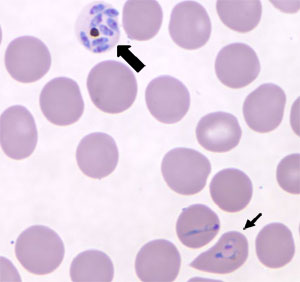Simian Malaria in Humans: Hard to Tell
Posted March 13, 2009 by Jimee Hwang

Malaria is preventable and treatable. However, each year 350–500 million cases of malaria occur worldwide, and more than a million people die, most of them young children in sub-Saharan Africa. In the U.S., about 1,500 people get malaria annually, almost all from traveling to countries where malaria is transmitted. In 2006, six people in the United States died from malaria.
In medical school, I learned that four species of Plasmodium cause malaria in humans—P. falciparum, P. vivax, P. ovale, or P. malariae. Numerous malaria species infect other animals but I learned that they were of little public health significance to humans.
However, that may no longer be true. Recent reports from Asia of P. knowlesi infection, a monkey or simian malaria species, in humans suggest that a fifth malaria species may be emerging as an important human pathogen or simply as a more frequently recognized zoonotic infection. In Asia, long-tailed and pig-tailed macaques and mitered-leaf monkeys are normal hosts for P. knowlesi, which overlap in distribution with Anopheles mosquito vectors, which can transmit infection to humans who encroach upon their habitat.
Infection of humans with monkey species of malaria was described long ago. In 1965, the first case of simian malaria imported into the United States was reported in a US military employee returning from Malaysia. Recently, researchers in Malaysia noticed that an unusually large number of cases of ‘P. malariae’ were being reported in their national surveillance system, including some fatal cases. These unusual findings prompted them to investigate and they discovered that what was being reported as cases of ‘P. malariae’ were actually large numbers of cases of P. knowlesi infections. These two parasites look very similar when viewed with a microscope. Since those reports were published, there have been several additional reports of travelers to and residents of Southeast Asia with P. knowlesi infections, including a recent case in a US traveler. The details of this case have just been published in the MMWR (Simian Malaria in a U.S. Traveler).

Giemsa-stained thin blood smear with schizonts (block arrow) and ring forms (thin arrow) of P. knowlesi from the reported case.
Although only one case of imported simian malaria in humans has been recognized recently, it’s clear that cases can be easily missed because under the microscope (the gold standard for lab diagnosis in the United States), the simian and human species look similar.
With the large number of recent human cases of simian malaria reported in Malaysia and the wider region, including the travel-associated case presented in the MMWR, we need to define the scope and magnitude of this problem.
CDC is requesting that health care providers of patients with malaria and laboratories that diagnose a case of malaria imported from Asia or non-falciparum malaria from South America refer appropriate specimens for species confirmation through a CLIA-approved State Health Reference Laboratory and/or the CDC Division of Parasitic Diseases Reference Laboratory for molecular testing (see instructions). Definitive diagnosis as a simian species of Plasmodium cannot be made in time to guide treatment, but fortunately all simian Plasmodium species are sensitive to chloroquine and other antimalarials available in the United States. Furthermore, following current treatment and chemoprophylaxis guidelines can effectively treat and prevent simian malaria infections in humans.
Comments
No comments posted.
Disclaimer: The content of Public Health Matters expresses the opinions of its authors and does not necessarily represent the views of the Centers for Disease Control and Prevention.
- Page last reviewed: March 13, 2009
- Page last updated: March 13, 2009
- Content source: National Center for Zoonotic, Vector-Borne, and Enteric Diseases
Get email updates
To receive email updates about this page, enter your email address:
Contact Us:
- Centers for Disease Control and Prevention
1600 Clifton Rd
Atlanta, GA 30333 - 800-CDC-INFO
(800-232-4636)
TTY: (888) 232-6348
24 Hours/Every Day - cdcinfo@cdc.gov


